Sorting Carbon Nanotubes and Their Biological Applications
Hyunkyu Oh, Sang-Yong Ju
Department of Chemistry, Yonsei University Seoul 120-749, Korea
Introduction
Carbon nanotubes (CNTs) have received much attention since their discovery in 1991 by Sumio lijima1 due to their excellent mechanical, electrical, and optical properties. Like other nanostructures (e.g., quantum dots, nanowires), the physical properties of CNTs are determined by the size and structure of the atoms. CNTs have great potential for applications in transistors, transparent films, infrared emitters, sensors, scanning probes, structural materials, catalysts, etc.2,3 Batch-produced CNTs contain a mixture with varying physical properties. Because performance depends on these properties, sorting these tubes by their physical properties (metallicity, chirality, handedness, length, etc.) is critical for cutting-edge applications. Here, we review several methodologies to purify CNTs according to their physical properties and describe related biological applications using the separated CNTs.
Single-walled carbon nanotubes (SWNTs) consist of a seamlessly rolledup graphene sheet with only sp2 carbons. SWNTs have physical properties dependent on the direction of the rolling vector (or chiral vector), termed by a pair of integers (n, m). If n - m is a multiple of 3, the tube displays a metallic character; otherwise, it is semiconducting with a bandgap around 1 eV. Semiconducting CNTs have an excitonic bandgap,4 which gives rise to photoluminescence (PL).5 The PL of CNTs is roughly inversely proportional to their diameter (dt). CNTs near 1 nm in diameter show PL around 1,200 nm, although the peak positions of PL are strongly dependent on the chirality of the CNT. Commercially available CoMoCAT® (Co-Mo bimetallic catalyst synthesized) tubes6 (Product Nos. 704113, 724777, 775533 and 773735) show PL in the range of 930-1,450 nm in the near infrared (NIR) regions. This NIR emitting feature is very useful for bioimaging, since the subcutaneous penetration depth of PL in the NIR region is much greater than for visible wavelengths.
Covalent vs. Noncovalent Functionalization
In order to attain biological functionalization of carbon nanotubes, two main methods (covalent and noncovalent functionalization) are generally employed. Covalent functionalization provides intact chemical functionalities on the carbon nanotubes, which can intimately interface with a biologically derived surface (shown in Figures 1A and 1B). However, covalent functionalization disrupts the integrity of the π-conjugated network of sidewalls and ends of carbon nanotubes, which affects their intrinsic properties. The carboxylation of CNTs, as seen in Product No. 755125, is the most popular covalent functionalization method and is accomplished by the oxidation of CNTs via carbodiimide chemistry.7-9 Strong acids (e.g., sulfuric acid and nitric acid) are used for the oxidative functionalization, which breaks the π-conjugated network on nanotubes and functionalizes nanotubes with oxygenated species (i.e., carboxylic acids and phenols).10 This leaves many defects behind and affects the optical, electrical, and mechanical properties of the CNTs.
Noncovalent functionalization of CNTs (Figures 1C through 1E) is generally achieved using molecules such as surfactants, polymers, biomolecules, and polyaromatic compounds.10 The noncovalent interaction relies mainly on either hydrophobic5,11 or π-π interactions12-14 without any destruction of the π network integrity of the CNTs. Moreover, useful intrinsic properties such as optical, electrical, and mechanical properties are preserved and solubility is improved. However, the dynamic equilibrium nature of polymers on nanotube surfaces can be a hurdle for some applications, such as target-specific binding and drug delivery. Therefore, it is necessary to utilize the physicochemical properties of CNTs, such as PL and sidewalls of CNTs as a nano conduit, as the advanced strategies for biological applications.
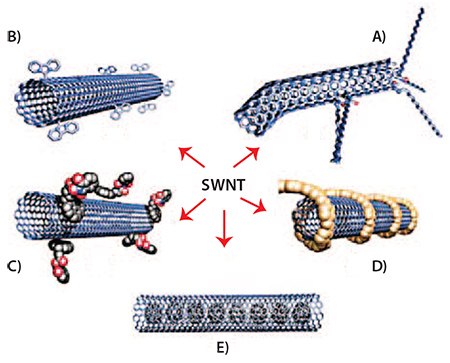
Figure 1.Functionalization strategies of SWNTs. Covalent functionalization using defectgroup (A) and sidewall of SWNTs (B); noncovalent functionalization using noncovalent exohedral surfactants (C), noncovalent exohedral polymers (D), and endohedral C60 (E). Adapted from Reference 15.
Sorting Methods
The separation efficiency of CNTs based on the noncovalent approach strongly depends on the degree of bundling. Since a nanotube bundle contains a mixture of metallic and semiconducting tubes with various chiralities, it is important to first produce a high degree of chirality of individual CNTs; then improve the separation efficiency of CNTs afterward. Nanotube bundling can be monitored by absorbance and photoluminescence spectroscopies. Small bundling of nanotubes results in a red shift by up to tens of meV from the absorbance peak of nanotubes in the NIR region.16 The degree of bundling is also evaluated from the peak intensity of PL caused by the energy transfer found at the cross-point of two different CNTs, which is proportional to the bundling size of CNTs.17 The noncovalent separation methodologies are listed in Table 1.
Examples of Sorting CNTs
Dielectrophoresis (DEP)
One of the initial efforts to sort CNTs by electronic type is the dielectrophoretic method.18 This process utilizes an alternating current (ac) DEP, where metallic nanotubes showing both a high dielectric constant and positive DEP are collected on the electrode for the high applied electric field, while semiconducting tubes having lower dielectric constant and negative DEP are left in the solvent. However, only small quantities of CNTs are collected by this method, and separation occurs solely by electronic type due to differences in polarizability in metallic and semiconducting CNTs.
DNA-based Ion Exchange Chromatography
This separation method is based on DNA-wrapped SWNTs, showing different electrostatic interactions with an ion exchange (IEX) column. A stable barrel is formed around the nanotubes with 2D H-bonding with single-stranded DNA (ssDNA) wrapped helically around individual CNTs (Figure 2A), exposing the deoxyribose phosphate. The selection of nanotubes is believed to originate from the electrostatic and electrodynamic interactions between the DNA barrel-nanotubes and the ion exchange resin.23 Pure chiral nanotubes were separated by this method for the first time.42 A recent experiment showed the improved structural motive of ssDNA allows for separation of 12 different chiral CNTs with 60-90% purity (Figure 2B).23 However, the estimated yield of chiral (n, m) tubes is very low; the majority of nanotubes are expected to be adsorbed onto the ion exchange column in a bundled state. A major drawback of SWNT separation by DNA-based ion exchange chromatography is the high cost of ssDNA used and expensive manufacturing process (i.e., high cost of the IEX column and its unavoidable replacement caused by clogging).
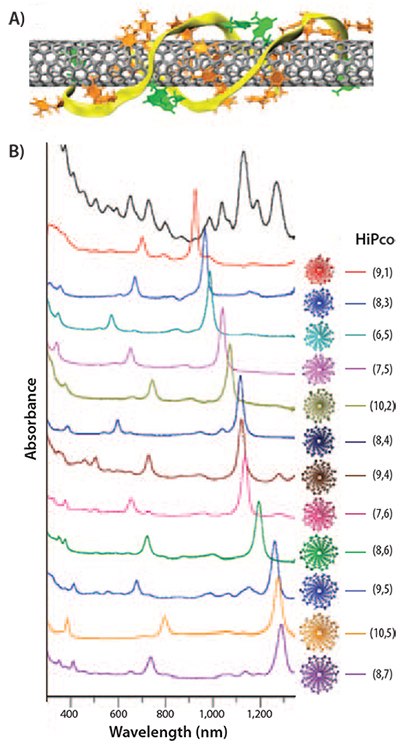
Figure 2.Separation of SWNTs using single-stranded DNA ribbons. A) Anti-parallel DNA (i.e., ATTTATTTATTT) strands wrap around (8,4) SWNT held by hydrogen bonding between DNA strands and ππ interaction between DNA and SWNTs. B) UV-Vis-NIR absorption spectra of 12 purified SWNTs with different chiralities separated by ion exchange column chromatography. Sorting of each SWNT can be enhanced by using different DNA sequences. Adapted from Reference 23.
Density Gradient Ultracentrifugation (DGU)
DGU separates nanotubes by the density difference of (n, m) CNTs in gradient medium using ultracentrifugation. CNTs dispersed in sodium cholate (or bile salt) exhibit different sediment coefficients according to their diameter, length, type (or metallicity), bundling, and even handedness.19,22,43 This method shows a variety of separation capabilities (Table 1). An example is illustrated in Figure 3, where color bands representing layer separation originate from the absorption of chiral CNTs. Iodixanol (Product No. D1556), an improved density gradient medium for DGU, allows adjustment of density from 1.32 (60 %) to 1.00 g/cm3 (0%), which covers the range of densities from the bundled (1.2-1.3 g/cm3) to individualized (1.0 g/cm3) nanotubes from the dispersed samples. Introduction of a cosurfactant such as sodium dodecyl sulfate (SDS) enhances the selectivity of specific chirality.19 For example, ten pure nanotubes with purity from 34 to 88% have been separated by DGU with a cosurfactant.22 It is noteworthy that nanotubes with smaller diameters exhibit a lower density. NanoIntegris produces SWNTs with specific chirality via the DGU method, which are commercially available (Product Nos. 750522 and 750530).
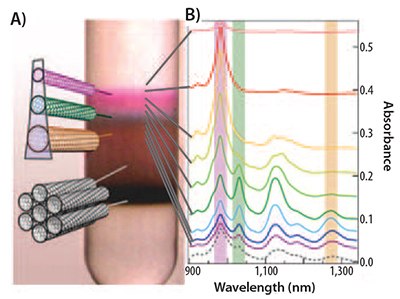
Figure 3.Sorting of SWNTs via density gradient ultracentrifugation (DGU). A) Upon ultracentrifugation (e.g., 200,000 g) using a swing bucket rotor, carbon nanotubes are sorted by their buoyancy (i.e., the highest buoyancy was exhibited from small diameter tubes) and are placed at their isopycnic point in the gradient gel. B) The corresponding NIR spectra of layered SWNTs after separation via DGU. Adapted from Reference 19.
Multi-column Gel Chromatography (MUGEC)
In MUGEC, several columns are connected vertically in series to obtain large-scale chirality separation. The selective adsorption of SWNTs dispersed in SDS on an allyl dextran-based gel column (Sephacryl® S-200HR, Product No. S200HR) allows for metallic vs. semiconducting separation and chirality-based separation of SWNTs. For thermodynamic reasons,44 metallic tubes exhibit more stability toward the gel medium and are eluted first, while semiconducting tubes are preferentially adsorbed onto the gel medium (Figure 4A). This sorting method is also highly dependent on diameter and chirality similar to DGU. The separation order of multi-column gel chromatography shows the nanotubes with small diameter were adsorbed first on the gel, indicating a high affinity to the dextran medium. Figure 4B illustrates the separation of 13 types of nanotubes by purity.24 This method is expected to provide relatively affordable chirality-pure nanotubes if a highthroughput separation is provided.
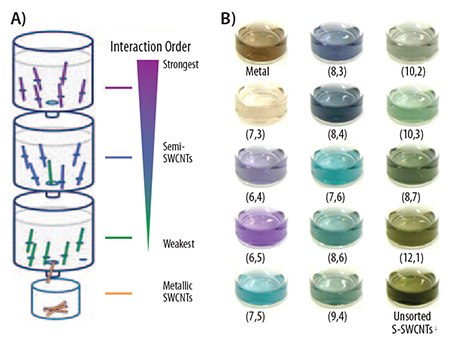
Figure 4.Chirality separation of SWNTs using allyl-dextran-based multi-column chromatography. A) Using SDS as a single surfactant, the dispersed SWNTs were adsorbed on column medium and, upon saturation, the single-chirality tubes are enriched according to its binding affinity toward the column. B) Bulk separation of iterative column chromatography to produce single chirality enriched SWNTs, showing their distinct colors according to their chirality. Adapted from Reference 24.
Flavin Mononucloetide (FMN)-based Titration
This method is comprised of the supramolecular helical wrapping of FMN onto a carbon nanotube surface (Figures 5A through 5C). This biomolecule exhibits distinct binding affinity or equilibrium constant toward cosurfactant titration, enabling (8,6) nanotube separation up to 85% purity (Figure 5D).25 In addition, the optically active d-ribityl phosphate group of FMN provides a chiral sheath for the equally chiral nanotubes, resulting in nanotube separation with enantioselective handedness (Figure 5E).26 Using the determined binding energy of FMN wrapping toward cosurfactant such as sodium dodecyl benzene sulfate (SDBS) on CNTs, this separation methodology might provide an affordable scale-up platform for selective CNTs.
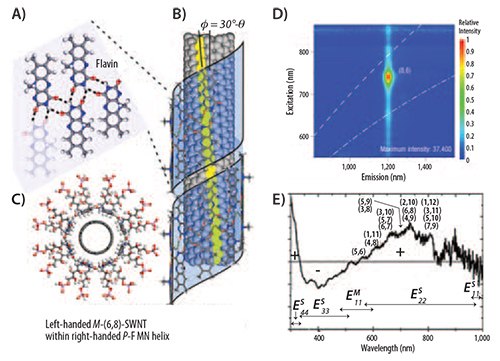
Figure 5.Flavin mononucleotide (FMN) self-organizes around SWNT through helical wrapping. A) 2D FMN sheet structure on the SWNT sidewall. One FMN forms quadruple hydrogen bonds with two facing FMNs. B) FMN possessing chiral d-ribityl phosphate group prefers left-handed SWNT within its own right-handed helical pattern. C) The phosphate side groups of FMNs impart SWNT dispersion by anionic repulsion. D) Photoluminescence mapping of separated (8,6) SWNT using dual-surfactant titration strategies. E) Circular dichroism spectrum of handedness of enantioselectively-separated SWNT using a dispersion of SWNT and FMN in aqueous solvents. Adapted from References 25,26.
Bio-application of Separated Carbon Nanotubes
CNTs have been used as novel biosensing platforms and nanoprobes for various biological targets. Many efforts employ CNTs as tools for cancer therapy. Clearly, surface chemistry, size, and degree of aggregation play critical roles in regulating CNTs′ interaction with cells. Therefore, CNT separation techniques can provide valuable tools for tailored imaging and cancer therapeutics.
However, toxicity has been one of the major concerns for CNTs′ use in biomedical applications. An in vivo study showed that CNTs functionalized with a polymer/surfactant seem to be safe even when orally fed to mice at a high dose (up to 1,000 mg/kg body weight).45 It was reported that intratracheal administration of ground, unfunctionalized CNTs aggregate in the lungs and led to pulmonary toxicity and inflammation.46 However, the aggregation effect (acute toxicity) was not observed for fluorescent individual SWNTs.47
Bioimaging Utilizing CNTs
Bioimaging capability of CNTs relies on their fluorescence. Fluorescence is one of the relaxation pathways of photo-excited molecules, which can be relaxed via either radiative (fluorescent) or nonradiative channels. The radiative, fluorescence quantum yield of carbon nanotube ranges from 0.1% to 20%, depending on the kind of surfactants and media.5,48 Since most surfactants are not biologically compatible, it is necessary to use a biologically compatible lipid such as a phospholipid-polyethylene glycol49 to attain the minimal dose of carbon nanotube.
Once nanotube-related biocompatibility and bundling issues are resolved, the separated CNTs require an adequate fluorescence range due to the strong absorption and scattering of human skin in the visible light region. It is desirable to utilize the near IR ranges (NIR I: 750-900 nm and NIR II: 1.0-1.4 μm),38 where absorption coefficients of human dermis and subdermis are approximately 0.02 and 0.1 per mm, respectively.50 It is known that near armchair nanotubes with smaller diameters have stronger photoluminescence.51 Recently, the Dai group demonstrated that chirality-enriched nanotubes (e.g., (12,1), and (11,3) tubes, Figure 6A) obtained via gel filtration method can be used for fluorescence in the NIR region. The separated nanotubes, whose excitation and emission are around 800 and 1,200 nm, respectively, not only enhances its fluorescence by 5-fold, but also provides a close match with an exciting NIR I laser line at 808 nm. Much brighter nanotubes significantly lower the dose of nanotube required, 0.16 mg/kg compared to a previous study using 1.0 mg/kg.38 Figure 6B shows the NIR image of a mouse after injection of chirality-enriched CNTs and comparison with organs identified with principal component analysis (PCA) (Figure 6C).
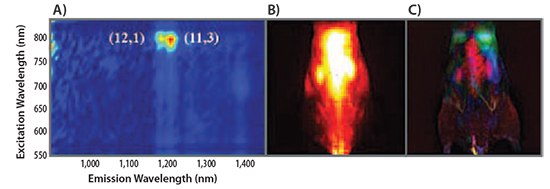
Figure 6.Real-time in vivo video imaging of whole mouse using chirality-enriched semiconducting SWNTs. A) PLE maps of chirality-sorted (12,1) and (11,3) SWNTs. B) In vivo whole mouse body imaging of NIR-II after injection of chirality-enriched SWNTs. C) Principal component analysis (PCA) image in which lungs, kidneys, and liver are color coded in green, pink, and blue, respectively. Adapted from Reference 39.
CNT-based Targeted Drug Delivery and Cancer Therapy
Covalently functionalized CNTs have been mainly used for in vitro targeted delivery vehicles for drugs, plasmid DNA, or small interfering RNA (siRNA) into cells by endocytosis. Covalent functionalization strategies for gene delivery utilize a primarily amine functionality of CNTs to stabilize anionic moieties of DNA. Figure 7 illustrates various approaches for CNT-based drug delivery and cancer therapy. Primary functionalization approaches targeting the interaction with biological entities are: 1) for the functionalization of antibodies, peptides, and small interfering RNA (siRNA); and 2) CNTs designed as a vehicle for molecular (or drug) delivery. The former can be utilized to deliver target ligands, chemotherapy drugs, and biomolecules via facile covalent chemistry on the surfactant. The latter utilizes either cleavable covalent chemistry onto CNTs or noncovalent interactions, such as van der Waals interactions, between CNTs and the drug. A clear departure from these approaches was obtained utilizing functionalization of hydrophobic sidewalls of carbon nanotubes. As shown in Figure 7, an aromatic drug such as doxorubicin interacts with CNT sidewalls via π–π stacking. Sidewall functionalized CNTs can hold up to 4 grams of drug per 1 gram of nanotubes, owing to CNTs′ large surface area. Interestingly, under an acidic pH environment, this drug favors the release of doxorubicin from the nanotube surface, which is suitable for treatment of tumor environment with local acidic environments.
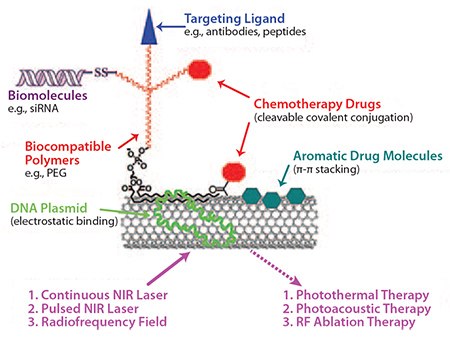
Figure 7.Schematic strategies of SWNTs-based drug-delivery and cancer therapy. Adapted from Reference 52.
In addition, CNTs can be used directly for the cancer therapy. Since photoexcited nanotubes relax by releasing thermal energy, this phenomenon can be utilized as photothermal therapy. If a short-pulsed laser is used, CNTs can act as nanobombs, when the incident power is beyond thermal conduction capability of nanotube, which is referred to photoacoustic therapy.53 Another strategy is to generate heat from CNTs using a radio frequency (RF) field. Since near 13.6 MHz RF field has excellent tissue penetration ability,54 this method can overcome the problems encountered by photothermal and photoacoustic therapies of CNTs.
Conclusion
Recent advances in sorting CNTs allow us to access chirality-pure carbon nanotubes with high purities. The separated CNTs, with their fine-tuned physical properties, can then be used in valuable, high-technology bioapplications. Although few examples of such applications are currently in use, appropriate carbon nanotubes with defined structure, electronic type, chirality, length, handedness, etc. show promising results for bioimaging, drug delivery, and other bio-related applications. Once the potential long-term toxicity of nanotubes is better understood, through a combination of photoluminescence, photothermal, and photoacoustic capabilities, CNTs will find extensive utility as tools for biomedical applications such as bioimaging, drug/gene delivery, and cancer therapy.
Materials
References
如要继续阅读,请登录或创建帐户。
暂无帐户?